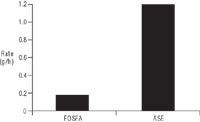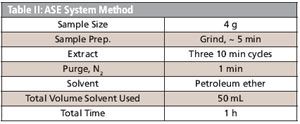Extraction of Oil from Oilseeds Using Accelerated Solvent Extraction (ASE)
Oils for foods and cooking are derived from oilseeds like canola, soybeans, corn, flax, and cotton.
Jennifer Peterson, Richard Carlson, Bruce Richter, and David Knowles, Dionex Corporation
Oils for foods and cooking are derived from oilseeds like canola, soybeans, corn, flax, and cotton. More recently, oil from oilseed crops has been used in the production of biodiesel. As a result, many agricultural companies are researching potential oilseed crops for maximum output of oil to be used for biodiesel. It is not only important to grow oilseeds that produce the best yields but also those crops that produce the best type of oil.

Figure 1: Rate of oil extraction from oilseeds.
Traditional solvent extraction techniques use large volumes of solvent (typically several hundred milliliters) and long extraction times (8–16 h) to remove oil from the seeds. Once the oil is removed, the weight percent of the oil seeds can be determined, and the composition of the oils can be studied.
Accelerated Solvent Extraction (ASE® ) uses high temperature and pressure to reduce the extraction time and solvent usage for solvent extraction. ASE has proven to be an effective technique for the extraction of oil from oilseeds.
Experimental
Canola seeds which contain approximately 45 weight percent oil were ground and weighed into an extraction cell. The ground seeds were extracted using 100% petroleum ether and 105 °C with three 10 min cycles. The extracts were evaporated to dryness, and the collection vials were weighed to determine the percent of oil.

Table I: AOCS Method AM 2-93
Results and Discussion
The ASE results were compared to the traditional AOCS (American Oil Chemist Society) Official Method AM 2-93 which is based on the FOSFA (Federation of Oil Seeds and Fat Association) Official Method (Table I).

Table II: ASE System Method
The weight percent of oil in the seeds was determined to be 44.9% with 0.31% RSD (n = 3) with ASE as compared to 45.2% with 0.24% RSD (n = 12) for the AOCS method. The weight of oil extracted per unit time is contrasted for ASE and the FOSFA procedure (see Figure 1).
Conclusions
The data shows that ASE can be used effectively to extract oil from oilseeds. The data generated are equivalent to those obtained by existing methods, but time and solvent usage are significantly less with ASE (Table II).
ASE is a registered trademark of Dionex Corporation.

Dionex Corporation
1228 Titan Way, P.O. Box 3603, Sunnyvale, CA 94088
tel. (408)737-0700; fax (408)730-9403
Website: www.dionex.com

SEC-MALS of Antibody Therapeutics—A Robust Method for In-Depth Sample Characterization
June 1st 2022Monoclonal antibodies (mAbs) are effective therapeutics for cancers, auto-immune diseases, viral infections, and other diseases. Recent developments in antibody therapeutics aim to add more specific binding regions (bi- and multi-specificity) to increase their effectiveness and/or to downsize the molecule to the specific binding regions (for example, scFv or Fab fragment) to achieve better penetration of the tissue. As the molecule gets more complex, the possible high and low molecular weight (H/LMW) impurities become more complex, too. In order to accurately analyze the various species, more advanced detection than ultraviolet (UV) is required to characterize a mAb sample.















